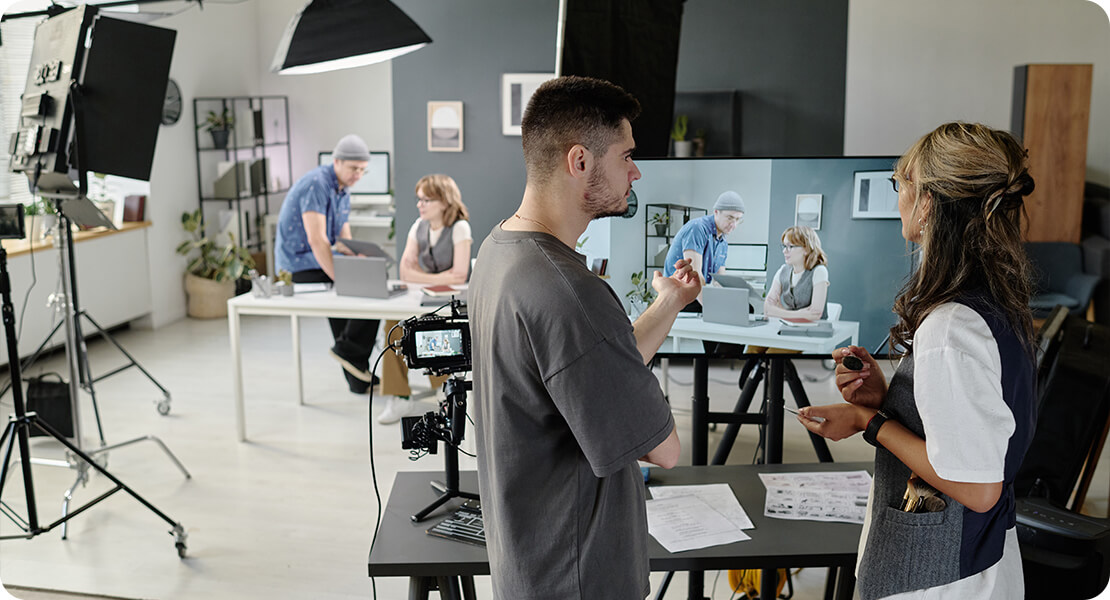
Corporate videos have come a long way from the dry, monotone productions of yesteryear. In today’s fast-paced digital world, businesses are increasingly leaning on internal staff—not seasoned performers—to deliver authentic, relatable on-screen messages. While this can make for more genuine content, it also introduces a unique set of challenges. After all, most employees didn’t sign up to be in front of a camera.
If you’re a director, videographer, marketing professional, or brand manager working on a corporate shoot with non-professional talent, your job is more than just “lights, camera, action”. It’s about coaching, comforting, and coaxing great performances from people who may be entirely out of their comfort zone.
In this article, we’ll explore practical techniques to help internal staff relax on camera, stay on message, and come across as confident, composed, and professional—even if it’s their first time in the spotlight.
1. Understand Your Talent’s Background
Corporate videos often feature internal staff who are not professional actors. It is essential to understand their comfort level in front of the camera to tailor your directing approach effectively. This insight helps you provide the right support so they can appear relaxed and natural.
Corporate videos often feature internal staff who are not professional actors. It is essential to understand their comfort level in front of the camera to tailor your directing approach effectively. This insight helps you provide the right support so they can appear relaxed and natural.
Each person has a unique style—some may be a bit nervous, while others might naturally enjoy being in front of the camera. You need to adjust your directing style according to their personality. When you identify and leverage their strengths, the results are far more authentic.
Understanding their professional background is also important because they will be more confident speaking about their own expertise. This authenticity makes the video feel genuine. Your role is to create a comfortable environment where they feel confident sharing their knowledge.
2. Set Clear Expectations Before Shooting
Before starting the shoot, it is crucial to clearly explain what the process will entail. Talent should know how long the shoot will last, when breaks will occur, and what is expected of them. This clarity helps reduce their anxiety and mentally prepare them.
Reassure them that perfection is not expected, and natural delivery is valued more highly. Multiple takes can sometimes cause frustration, so encourage them to speak in their own style. This approach results in more relaxed and effective performances.
Also, brief them on the purpose of the video, its intended audience, and where it will be shown. When talent understands their role and the impact of their contribution, they perform with greater confidence. Open communication upfront sets a positive tone for the shoot.
3. Create a Comfortable Environment

A comfortable and friendly environment helps non-actors perform at their best and maintain focus. Choose a quiet and familiar setting with minimal distractions, along with comfortable lighting and temperature. This reduces stress and increases concentration.
Offering refreshments and comfortable seating during breaks helps keep energy levels high. Frequent breaks prevent fatigue and frustration, significantly boosting morale. Small thoughtful gestures like these help talent feel valued and supported.
Minimise crew noise and unnecessary movement to maintain a calm atmosphere. Friendly and supportive communication during the shoot helps ease nerves. When people feel appreciated, their performances become more natural and engaging.
4. Use Simple, Conversational Language
When directing non-actors, keep the language simple and easy to understand. Avoid technical jargon or complicated phrasing that might confuse them. A conversational tone helps them speak naturally and connect with the audience.
Encourage them to communicate as if talking to a colleague or friend. This makes the delivery sound genuine and relatable on camera. Natural language enhances engagement and keeps viewers interested.
Regular practice with bullet points or prompts, rather than full scripts, encourages spontaneity. This helps non-actors express ideas in their own words, adding authenticity. Simple, clear language helps maintain a smooth flow.
5. Give Clear and Positive Direction
Non-actors respond well to clear, positive, and specific feedback. Using encouraging phrases like “That was great” or “Let’s try this slightly differently” boosts their confidence. Negative or vague instructions can increase anxiety and hinder performance.
Keep your directions simple and actionable. For example, say “Look slightly to your left” rather than “Change your angle.” Demonstrating what you want can also help them understand better.
Provide gentle, constructive feedback focused on improvement rather than criticism. Praise small successes to keep their motivation high. Your patience and kindness are key to guiding them effectively.
6. Encourage Natural Body Language
Non-actors often appear stiff or uncomfortable on camera, so help them relax their body. Suggest simple movements like shifting their weight, using natural hand gestures, or smiling gently. These small actions make them look more confident and approachable.
Avoid closed-off postures such as crossed arms, which can appear defensive. Encourage an open and welcoming stance to reflect confidence. Mirroring their energy can help them feel more comfortable and engaged.
Natural and subtle movements convey authenticity, which audiences appreciate. It’s better to have gentle, confident gestures than exaggerated or forced ones. Frequent breaks help keep their body language fluid and relaxed.
7. Help Manage Speaking Pace and Volume
Non-actors often speak too quickly or too quietly when they feel nervous, which can reduce clarity. Encouraging them to slow down slightly and take natural pauses allows their message to come across clearly and confidently. It also helps with breathing and prevents the delivery from sounding rushed or anxious.
Volume control is equally important; speaking too softly may cause important points to be lost, while shouting sounds unnatural and distracting. Guide your talent to project their voice as if they are speaking to a colleague in a quiet office, ensuring that every word is captured crisply by the microphone. Regularly monitoring audio levels during the shoot helps you catch issues before they become a problem.
Encourage your talent to practice reading their lines aloud with varied intonation and pauses to emphasise key points. This practice builds awareness of their rhythm and volume, helping them maintain listener interest. Ultimately, a well-paced and well-projected voice makes the video more engaging and professional.
8. Use Repetition and Practice
Repetition is key to building confidence for those unaccustomed to being on camera. Running through the script multiple times before recording helps non-actors internalise the flow and reduces anxiety. Each rehearsal increases familiarity, which translates to a smoother and more natural delivery.
Recording practice takes and reviewing them together gives talent a chance to self-correct and improve. Visual feedback empowers them to see their strengths and areas needing refinement. This collaborative process creates a supportive environment where improvement feels achievable.
Balancing practice with rest is essential to avoid fatigue and loss of focus. Encourage short breaks to refresh energy and maintain enthusiasm. With consistent, thoughtful practice, non-actors can deliver performances that feel authentic and polished.
9. Break the Script into Manageable Sections
Large blocks of text can overwhelm non-professional speakers, increasing the risk of mistakes and nervousness. Breaking the script into small, manageable chunks helps keep focus sharp and delivery natural. This approach makes memorisation easier and reduces cognitive load.
Short sections also allow for more frequent breaks and retakes without frustration. They make it simpler for talent to reset and maintain energy throughout the shoot. It also gives editors more flexibility to arrange content dynamically.
Providing cue cards or teleprompters displaying bullet points rather than full sentences supports spontaneity. This encourages talent to express ideas in their own words, which enhances authenticity. A segmented script ultimately helps maintain clarity and flow for viewers.
10. Minimise the Number of Takes
Excessive retakes can quickly drain energy and increase stress for non-actors. Encouraging your talent to focus on natural delivery rather than perfection helps keep the mood positive and relaxed. A genuine performance often resonates more with viewers than a flawless but stiff one.
Set the expectation that small mistakes are acceptable and even relatable. This mindset eases pressure and reduces the chance of overthinking each line. Sometimes, spontaneous moments or minor imperfections add authenticity and charm.
However, don’t settle for unusable footage—ensure the take conveys the intended message clearly. Balance efficiency with quality by recognising when a take is good enough. This approach keeps production on schedule without sacrificing professionalism.
11. Use Warm-Up Exercises
Starting your shoot with vocal and physical warm-ups helps prepare non-actors for the camera. Simple breathing exercises reduce tension and improve voice control. Gentle stretches release physical stiffness and promote relaxed body language.
Encourage tongue twisters or reading aloud to improve articulation and focus. These exercises loosen the mouth muscles and boost confidence in speaking clearly. Taking time for warm-ups signals a professional and caring environment.
Warm-ups also create a shared ritual that eases nerves and builds camaraderie. This can help shift the group’s energy from anxious to engaged. Overall, preparation sets a positive tone for the entire shoot.
12. Build Trust with Your Talent

Building trust is essential for a successful shoot with non-actors. Show patience, empathy, and genuine interest in their comfort and success. A trusting relationship allows talent to express themselves honestly and openly on camera.
Maintain consistent eye contact and active listening to create connection. Respond positively to their concerns and encourage questions. This supportive dynamic helps reduce anxiety and fosters cooperation.
Trust also empowers talent to take risks and experiment with their delivery. They’re more likely to go beyond rehearsed lines when they feel safe. Creating this environment elevates the quality of the video and the experience for everyone involved.
13. Simplify Technical Setups
Non-actors often feel intimidated by complicated camera and lighting equipment. Keeping the setup minimal and unobtrusive helps them focus on their performance rather than the gear. When talent understands what each piece of equipment does in simple terms, it reduces their anxiety and increases cooperation.
Explain the roles of microphones, cameras, and lights clearly before filming starts. Demystifying the technology lets talent feel more comfortable and engaged. Avoid overwhelming them with technical jargon; instead, use everyday language that everyone can grasp easily.
Also, limit the number of crew members on set to avoid creating a distracting or crowded atmosphere. A smaller, quieter crew helps maintain a calm environment. This makes non-actors feel safer and more at ease, leading to better performances.
14. Control the Environment
Maintaining a controlled and quiet filming environment is crucial for capturing clean audio and sharp visuals. Minimise potential interruptions like phone rings, doorbells, or foot traffic during the shoot. This focus creates a professional atmosphere that benefits both talent and crew.
Ensure lighting conditions remain consistent throughout filming to avoid distracting fluctuations. Inform anyone nearby about the shoot schedule to reduce unexpected noise or movement. Setting up clear boundaries and signs can prevent accidental intrusions.
A stable environment allows non-actors to concentrate fully on their delivery without distractions. This sense of professionalism helps build their confidence. Managing environmental factors contributes significantly to a smooth and efficient shoot.
15. Use Positive Reinforcement
Positive reinforcement is one of the most powerful tools when directing non-actors. Complimenting good posture, clear speech, or genuine expressions boosts confidence instantly. Non-actors thrive on encouragement and are more likely to improve when praised.
Offer specific feedback rather than general comments. Saying “Your smile here looks very natural” is more effective than “Good job.” This targeted praise helps talent understand exactly what works well.
Avoid harsh criticism or negative language that could increase nervousness. Frame suggestions constructively, focusing on solutions instead of faults. Celebrating progress creates a supportive environment that nurtures better performances.
16. Manage Time Efficiently
Time management is crucial when working with non-actors because they can tire easily and lose focus quickly. It’s important to structure the shoot with regular short breaks to keep their energy levels up. Clear communication about the schedule also helps talent know when they can relax and how to pace themselves.

Efficient planning ensures the shoot progresses smoothly without unnecessary delays. When non-actors understand the timing and flow of the shoot, they feel more confident and less anxious. Striking a balance between being productive and not rushing is key to maintaining high-quality performances.
Sometimes unexpected challenges arise, so flexibility in your timing is essential. If your talent needs extra time to feel comfortable or deliver a line properly, provide it patiently. Time management isn’t just about speed; it’s about keeping the shoot focused and smooth.
17. Prepare for Emotional Responses
Being on camera can be an emotionally challenging experience for many non-actors. They may feel nervous, self-conscious, or overwhelmed during the shoot. As a director, you need to be patient and empathetic to help them manage these feelings effectively.
Give them space to express their emotions without judgment, allowing breaks when necessary to regain confidence. Creating a warm and positive environment builds trust and encourages openness. Supporting your talent emotionally leads to better, more genuine performances.
Light humor and casual conversation can help reduce tension and relax the atmosphere. A few moments of laughter can break the ice and boost morale. When people feel at ease, their on-camera presence becomes naturally stronger.
18. Focus on Eye Contact and Facial Expression
Eye contact is one of the most important elements for engaging viewers in corporate videos. Guide your talent to look naturally at the interviewer or just off-camera rather than staring directly into the lens, which can feel forced, especially for beginners. This subtle direction helps maintain a conversational and approachable tone.
Encourage a range of facial expressions to match the message being delivered. Genuine smiles, thoughtful looks, and appropriate reactions make the content more relatable and dynamic. Avoid blank or stiff expressions, as they can make the video seem dull and disconnected.
Review practice footage with your talent to increase their awareness of how their facial expressions come across. This helps them adjust subtle gestures and develop a natural presence. Over time, relaxed and expressive faces help build trust and keep the audience engaged.
19. Coach on Voice Tone and Inflection
A monotonous voice can quickly lose an audience’s attention, especially in corporate videos where engagement is key. Guide your talent to vary their pitch, speed, and volume to keep the delivery dynamic and interesting. Using inflections to emphasise important points makes the message more memorable and impactful.
Demonstrate examples of effective voice modulation to help them understand how to add emotion and energy without sounding forced. Encourage natural pauses and changes in tempo to let key ideas resonate. This coaching helps non-actors avoid a flat or robotic delivery.
Recording practice takes and reviewing them together builds awareness of tone and expression. Positive feedback on improvements boosts confidence. When done right, voice tone and inflection turn a simple message into a compelling story.
20. Debrief and Provide Encouragement Post-Shoot
After filming wraps, hold a friendly debrief session with your talent to review highlights and provide constructive feedback. Acknowledge their strengths and memorable moments to reinforce positive behaviours. This boosts morale and motivates them for future videos.
Explain the next steps clearly, including editing timelines and possible reshoots, so they feel informed and involved. Keeping communication open post-shoot builds trust and rapport. Encourage questions to clarify any uncertainties.
Thanking your talent sincerely for their effort and participation fosters goodwill. Positive relationships lead to smoother shoots down the line and better collaborations. Remember, appreciation goes a long way in the world of corporate video production.
Final Thoughts: Empowering Non-Actors to Shine on Camera
Directing non-actors in corporate videos requires patience, empathy, and clear communication. By understanding your talent and creating a comfortable environment, you help them deliver authentic and professional performances. You can contact us to take your video production to the next level with expert coaching and seamless shoots.
With the right approach, even those new to camera work can shine and effectively convey your brand’s message. Preparation, positive reinforcement, and practical techniques are the keys to success. Every video improves when your subjects feel confident and supported.

